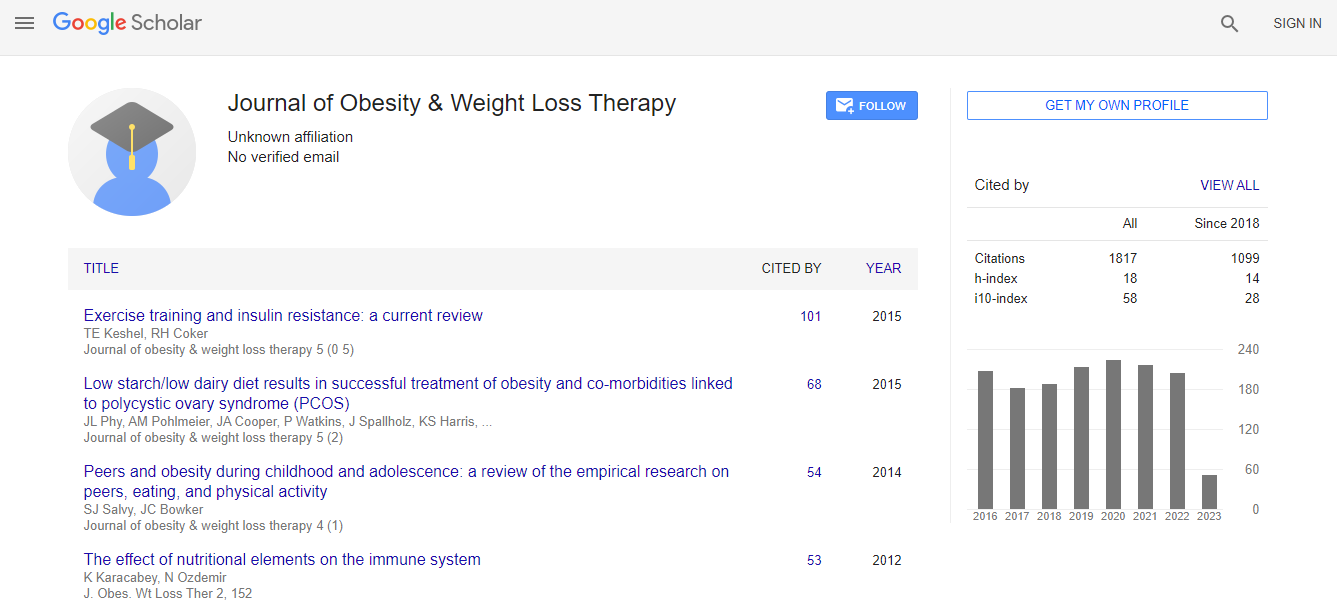Our Group organises 3000+ Global Conferenceseries Events every year across USA, Europe & Asia with support from 1000 more scientific Societies and Publishes 700+ Open Access Journals which contains over 50000 eminent personalities, reputed scientists as editorial board members.
Open Access Journals gaining more Readers and Citations
700 Journals and 15,000,000 Readers Each Journal is getting 25,000+ Readers
Google Scholar citation report
Citations : 2305
Journal of Obesity & Weight Loss Therapy received 2305 citations as per Google Scholar report
Journal of Obesity & Weight Loss Therapy peer review process verified at publons
Indexed In
- Index Copernicus
- Google Scholar
- Open J Gate
- Genamics JournalSeek
- Centre for Agriculture and Biosciences International (CABI)
- RefSeek
- Hamdard University
- EBSCO A-Z
- OCLC- WorldCat
- SWB online catalog
- CABI full text
- Cab direct
- Publons
- Geneva Foundation for Medical Education and Research
- Euro Pub
- University of Bristol
- Pubmed
- ICMJE
Useful Links
Recommended Journals
Related Subjects
Share This Page
A net structure bariatric surgery device with silicone materials
19th International Conference on Obesity, Healthcare - Nutrition & Fitness
Teng Zhang
Columbia University, USA
ScientificTracks Abstracts: J Obes Weight Loss Ther
Abstract
Introduction: Silicone rubber has excellent biocompatibility and good mechanical properties, which makes it a valuable candidate for the implantable medical device. Bariatric surgery is considered the most effective treatment option for morbid obesity. This paper tests the feasibility of designing a net-shaped device to control stomach capacity.Methods: The net-shaped bariatric device is custom made for each patient by 3D printing using silicone based on a physician’s assessment of height, weight, and energy consumption of obese patients. The device is placed on the outer wall of the patient’s stomach by laparoscopic surgery. Due to its good elasticity and toughness of the silicone rubber, a patient’s stomach is getting constrained gradually by the device during the feeding process, until the constrain reaches a threshold to achieve the purpose of weight control. The function of the netshaped device was tested by simulation experiments using a balloon as the model for the stomach. The pressure pump inflates to simulate feeding process. Our experiment uses a control group with balloons only and a testing group with a basket over the balloons. For both groups, the balloon was injected with air at a constant pressure stream. When the pressure reached a certain level, the volume of the balloon w/o the device was recorded. The relationship between the volume and pressure for different hardness, thickness and braid density of the device was measured.
Results: In the control group, the balloon tripled in size when the pressure pump stopped filling; while the volume of the balloon in the control group increased by 0.5 times. The hardness, thickness, and braid density have a lot effect on the expanding volume, and the silicone with 25D (shore hardness), 0.2mm in thickness and 35 PPI seems to be optimal in performance.
Discussion: A net-shaped bariatric surgical device made of silicone were designed and prepared. The preliminary function of the device was tested using a simulation system, and the design parameters of the device were optimized.
Biography
E-mail: tz2367@columbia.edu

 Spanish
Spanish  Chinese
Chinese  Russian
Russian  German
German  French
French  Japanese
Japanese  Portuguese
Portuguese  Hindi
Hindi 
